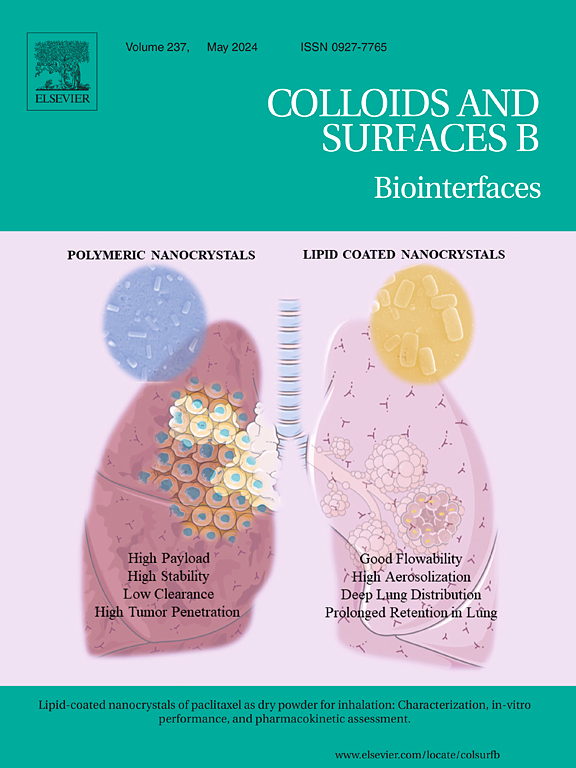Effect of polysaccharides on the inhibition and binding ability of hesperetin-copper(II) complex on α-glucosidase
IF 5.4
2区 医学
Q1 BIOPHYSICS
引用次数: 0
Abstract
The study aimed to investigate the inhibitory effect of hesperetin-copper (II) [Hsp-Cu(II)] on α-glucosidase in the presence of polysaccharides (xylan, β-glucan, low-, medium- and high-viscosity chitosan). The results showed that all the polysaccharides significantly reduced the inhibitory activity of α-glucosidase by Hsp-Cu(II), and the reduction effect of high-viscosity chitosan was the most significant. The polysaccharides significantly decreased the binding constant of Hsp-Cu(II)![]() α-glucosidase, changed the binding sites of Hsp-Cu(II) to α-glucosidase and reduced the hydrogen bonds of Hsp-Cu(II) bound with α-glucosidase. Circular dichroism showed that the reduction of α-helix content in α-glucosidase caused by Hsp-Cu(II) was raised from 27.2 % to 29.5 %, 31.3 % and 32.7 % in the presence of xylan, β-glucan and high-viscosity chitosan, respectively, suggesting that the polysaccharides could restore the secondary structure of α-glucosidase. Fourier transforms infrared spectra showed that xylan and β-glucan formed hydrogen bonds with Hsp-Cu(II). The mechanism of the decreasing effect might be that the polysaccharides with the low viscosity compete with α-glucosidase to bind Hsp-Cu(II) through hydrogen bonds, restoring the catalytic center and active amino acid residues of Hsp-Cu(II) bound with α-glucosidase and the adsorption of high-viscosity chitosan decreases the binding affinity of Hsp-Cu(II) on α-glucosidase. The study may offer a reference for the development of Hsp-Cu(II)-based nutritional and healthy food for patients with hyperglycemia.
α-glucosidase, changed the binding sites of Hsp-Cu(II) to α-glucosidase and reduced the hydrogen bonds of Hsp-Cu(II) bound with α-glucosidase. Circular dichroism showed that the reduction of α-helix content in α-glucosidase caused by Hsp-Cu(II) was raised from 27.2 % to 29.5 %, 31.3 % and 32.7 % in the presence of xylan, β-glucan and high-viscosity chitosan, respectively, suggesting that the polysaccharides could restore the secondary structure of α-glucosidase. Fourier transforms infrared spectra showed that xylan and β-glucan formed hydrogen bonds with Hsp-Cu(II). The mechanism of the decreasing effect might be that the polysaccharides with the low viscosity compete with α-glucosidase to bind Hsp-Cu(II) through hydrogen bonds, restoring the catalytic center and active amino acid residues of Hsp-Cu(II) bound with α-glucosidase and the adsorption of high-viscosity chitosan decreases the binding affinity of Hsp-Cu(II) on α-glucosidase. The study may offer a reference for the development of Hsp-Cu(II)-based nutritional and healthy food for patients with hyperglycemia.
求助全文
约1分钟内获得全文
求助全文
来源期刊

Colloids and Surfaces B: Biointerfaces
生物-材料科学:生物材料
CiteScore
11.10
自引率
3.40%
发文量
730
审稿时长
42 days
期刊介绍:
Colloids and Surfaces B: Biointerfaces is an international journal devoted to fundamental and applied research on colloid and interfacial phenomena in relation to systems of biological origin, having particular relevance to the medical, pharmaceutical, biotechnological, food and cosmetic fields.
Submissions that: (1) deal solely with biological phenomena and do not describe the physico-chemical or colloid-chemical background and/or mechanism of the phenomena, and (2) deal solely with colloid/interfacial phenomena and do not have appropriate biological content or relevance, are outside the scope of the journal and will not be considered for publication.
The journal publishes regular research papers, reviews, short communications and invited perspective articles, called BioInterface Perspectives. The BioInterface Perspective provide researchers the opportunity to review their own work, as well as provide insight into the work of others that inspired and influenced the author. Regular articles should have a maximum total length of 6,000 words. In addition, a (combined) maximum of 8 normal-sized figures and/or tables is allowed (so for instance 3 tables and 5 figures). For multiple-panel figures each set of two panels equates to one figure. Short communications should not exceed half of the above. It is required to give on the article cover page a short statistical summary of the article listing the total number of words and tables/figures.
 求助内容:
求助内容: 应助结果提醒方式:
应助结果提醒方式:


